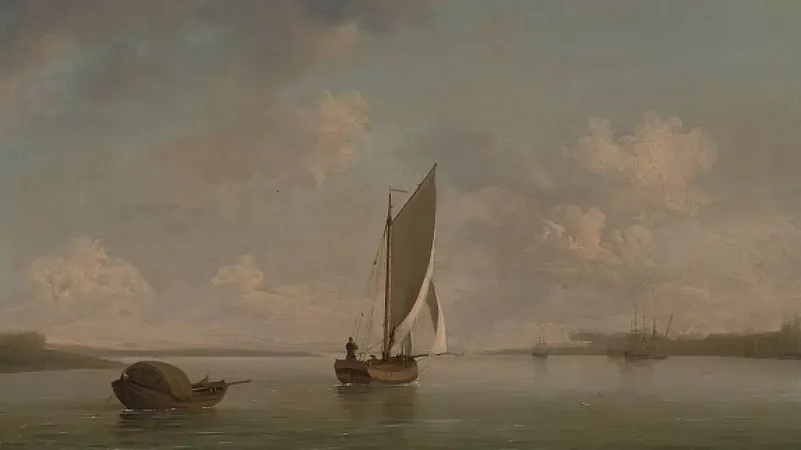Rescuing a River Breeze: By Mrinalini Harchandrai
Published by Bloomsbury India 2023
The mesmeric pull of memory’s tide hauls in a message of bottled girlhood, holding within its brittle translucence a sensory constellation of imaginings. Mrinalini Harchandrai is the creatrix bringing us this polyphonic voicescape of diasporic selves distilled from family lore, received histories, seething voids, speculative fabulations, and brimming curious questions arising from a mutating moment in Goa’s history. Kinesthetic hues on the cover of her debut novel Rescuing a River Breeze are brushed in with a flourish of emblematic maritime iconography by Mugda Sadhwani. The featured dhow appears adrift in wind-churned foam, as a lone seagull soars into the beyond like a thought in flight. The flower bedecked ornamentation of deep blue and yellow framing of this scene is suggestive of a painting, fitting for the book’s panoramic tableau of 60’s Goa, amid hovering winds of change. A finely crafted word mandala weaving sound and surf into a fluid coherence is masterfully orchestrated by Mrinalini as she gleans stories from the subvisible remnants of a bygone era.
Mrinalini's unique narrative capacities include making the oral culture of a lost time vividly audible. The adversarial politics spicing the trepidations of local families, the genteel Portuguese imports in their well-heeled decadence, the weathered fisherfolk with their seasoned subaltern knowhow, the complicated nuns wielding their austere regimentation, the prankster schoolgirls pushing the normative envelope, and the shady dealings of treasonous agents under the radar of their colonial overlords—are all sketched in stunningly lively detail. But it is the artistry of Mrinalini’s subtle semiotic significations that enables vicarious participation by the reader who is transported to the Goa of lush mangroves, swampy marshes, and pristine beaches before it was plunged into chaotic limbo by the Indian Government's aggressive intervention to take back the colonized region from the appropriating Portuguese.
For those familiar with the contemporary popularity of Goa as a party hotspot with a burgeoning urban sprawl, this book provides a retro immersion—a time capsule, where a fictionalized recreation of former Goa provides insights into the zeitgeist of its citizenry at the time. Mrinalini casts a luminous eye on a gray area where questions remain about the longevity of deep societal ties to Portugal and psychological anchorage in its culture even after the sudden shift in power dynamics during the 60’s. Mrinalini’s exploratory sensibilities do not directly dwell on the provincial marrow of its scaffoldings; instead, she channels her own instincts through the emotional turf of homelife in a tale revealing the microdramas of the Quarachim family’s daily routines. Transplants from Sindh settled in Goa, Deepak and Mamtu Quarachim dote on their young daughters as their bustling household reveals a network of relationships seen through the eyes of Shirly, their thirteen-year old. Her ritual of gazing through the window at the daily Portuguese flag hoisting is a recurring image throughout the novel. This visual acquires deepening resonance that lingers through the plot twists.
Young Shirly’s communications with inanimate kin are a touch of whimsy in this tale of innocence, tremulously aware of its own subliminal stirrings within and without. Her private conversations with the stone figure of Abbé Faria, the “magical, paternal statue man”, infuse a local mythology with new life. Its osmotic genealogies spring from the sensorial landscape of “home" with competing forces at play in its definition. They arise in a child’s foray through the aperture of fantasy, in echoes of ancestral displacement, and in adoption of new locales in search of opportunity. The backdrop of Shirly’s world provides an archaeology of confluences: there is foe-turned bestie Ana’s home where Shirly gets awed by opulent soirees and feels the first flutterings of young love. Then there is the looming school musical which influences her self-image as its lead role acquired in dubious circumstances—ironically, a punitive nun’s revenge for her high-pitched scream flouting school rules! There is the dynamic father, a loving patriarch with a heroic mystique who gets enmeshed in machinations beyond his control. There is the pregnant mother, a sheltering presence even in her vulnerability.
And for comic relief, we have a loyal but salty maid Goku whose hilarious choice of a universal panacea for all afflictions is the elixir “feni.” The endearing ubiquity of translanguaging in the Quarachim home is a guttural brew of Sindhi, Konkani, English, and Portuguese—even cuss words are colorfully sequenced: “chari-pishem-nutcase-louco." These figures and their mannerisms are showcased with vivid immediacy, as are their surroundings down to the smell of fresh fish—a major part of coastal cuisine. As motley characters energize this world of plenitude and communal vibrance, we witness creeping tentacles beginning their siege in the violet hour before the collapse of all scaffoldings, of intersubjective existences, and a sense of place evolved from a colonial encounter spanning years and exponentially magnified in the hearts of its occupants.
The apocalyptic roar of hegemonies in combat after intrigues involving the imprisonment of her father, the disruption of her schoolgirl routines, and a series of cliff hangers with her friend Ana and her charismatic brother, lead Shirly into a dark tunnel where Portuguese brokers of power negotiate the fate of Goa in reportage to Prime Minister Salazar with the callous threat of scorched earth intentions and obliteration of her world. While the privilege of hindsight gives the reader an edge in the historical knowledge that the Governor General did not follow through, the preceding scenario of relentless terror can only be fleshed out in the hermetic neural maze of witness records. Surrounding Shirly in the buildup to the cataclysmic changes, are seemingly enduring vignettes ranging from scenic vistas of the river dotted with dhows, the alluringly mellifluous Dona Lisette’s glamorous dwelling and sartorial elegance, all amid a parallel flow of migratory family reminiscences. Subtle foreshadowing in the beginning of the novel in the referencing of a breeze “using its knuckle of branches to knock on the window with a sorrow older than desire” leads inexorably to the crescendo of impact when the bestial heart of man’s territorial impulse beats deafeningly and shreds the dreams, hopes, relationships and security of the familial havens at the banks of a river carrying their predictable lives to the turbulent shores of change.
The tectonic existential shifts brewing in the expected rupture of a cartographically stable albeit colonized homeland cause unease, as the ecological embedding of neighborhoods is threatened following the sudden arrest of Deepak. The family’s descent into uncertainty causes Mamtu’s world to implode and she agitatedly tries to keep the boat afloat without anchorage. The sedimented palimpsests silently residing within her mind of displaced Sindhis and their way of life are brilliantly evoked by nostalgic reminiscences of her childhood in Karachi. Her Panjim home has the loving recreation of the warm culinary aura of her doting grandmother's aromatic kitchen, where she invoked Saint Jhulelal while dragging on her “beedi” (tobacco leaf wrap) and sipping her chai. Mamtu affectionately nicknamed “thadal” (cool sweet drink) by this towering matriarch can still taste her delectable “boondi laddoo” (syrupy gram flour balls) through the mists of time, and uses this soul hearth as her emotional vocabulary. The welcoming table she sets for her husband every day recalls this legacy, and compounds the distress caused by its disruption.
Mrinalini defies ossified interpretations of a righteous anti-colonial mission in this cameo of a fictional family’s journey. It reflects her daring as a writer. She treads upon a morphological cocoon and releases the singed echoes of lives interrupted. There are no neat binaries attached to the idea of liberation. How did a young resident of 1960s Goa weather the storm of violently imposed circumstances? She became the storm… and the calm that followed—this is magnificently conveyed through Mrinalini’s suggestive revelations as she peeks through the cracks in historical blinders. Young Shirly, the reader imagines, has consigned her innermost longings to the cavernous depth of the River Mandovi, and decades later as a mother herself, lets them surface in pearlescent words as her daughter befriends a familiar statuesque presence, a weathered witness of her younger self.
Mrinalini stands poised as a guardian of new thresholds as she immerses us in the metaphysics of presence through the vasculature of ancestral memory. The waves of Goa’s shoreline are quantum inclinations of resurrected voices that linger and whet the imaginative appetite. Mrinalini’s parsing of historical parchments in her sojourns of research have the rich flavor of her intuitive scholarship. She eschews the metajudgemental mode of baked-in assumptions, anarchic pathologies, and discordant tribalism. Instead, we have the silken trails of mother Mamtu's tears, the affective geography of her quivering hopes for her husband’s safety and survival, and the architecture of her crystallized dreams in novelistic terrain that is imbued with a poetics of the corporeal, the elemental, and ethereal. Her daughter’s coming of age as she prances from innocence to an audaciously renegade adventure of youth happens during sociological upheaval - a fissure from which she must negotiate a way forward.
A remarkable novel, delving into the anatomy of intergenerationally and implicitly experienced loss and renewal, Rescuing a River Breeze is a compositional feat of introspective depth and autonomy, with a stylistic idiom of anecdotal storytelling that ambitiously questions the ordered and bordered realm forged within the aesthetics of representation itself.


























